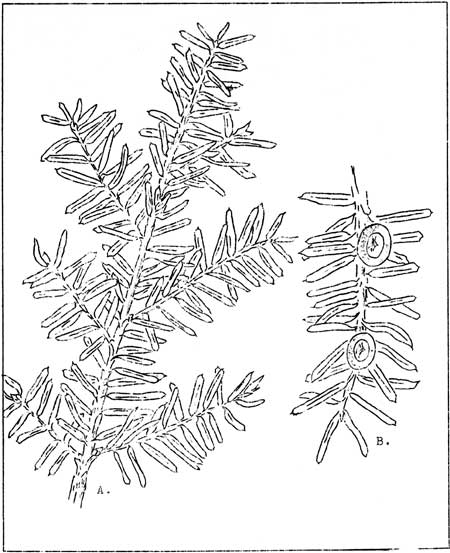WESTERN YEW.
(Taxus brevifolia)
This interesting evergreen is fairly common in the deep forests of
Mount Rainier National Park up to an elevation of 4000 feet. It is not a
large tree, being generally from 3-12 inches in diameter and from
15-25 feet tall. However, specimens 24 inches in diameter and 40
feet tall have been observed. The trunk is characteristically ridged and
fluted and the thin reddish-brown outer bark scales off in thin
irregular plates to expose the rose-red inner bark to view. The
needles are flat, up to 3/4 of an inch in length, dark
yellow-green on the upper side and pale green below, soft to the touch
and tipped with a short, slender point. While the needles are arranged
spirally upon the branches, a twist at the base gives them the
appearance of being arranged comb-like on either side of the twig. In
late June and early July one will notice the small bud-like. yellowish,
staminate flowers which are borne abundantly upon the under side of the
branches. The greenish pistillate flowers, also borne upon the underside
of the branches, are not as numerous but these later develop into a very
handsome fruit, 1/4-1/2 inch in diameter, which is composed of a hard
green seed partly surrounded by a fleshy, gelatinous, bright red disk or
aril. Birds eat this fruit, as they are attracted by the color of the
fleshy disk, and Sudworth states that the seeds of the tree are
disseminated in this manner as the hard seed is not injured by digestive
processes. The wood is durable, reddish in color, and very heavy. It was
originally used by the Indians of the Pacific Northwest in the
manufacture of harpoons, canoe paddles, etc. while in more recent years
it has become highly prized a s material for bows by devotees of the
modern version of archery. It is a tree of slow growth and presumably,
it attains a great age. A specimen in the park museum at Longmire, which
is eight inches in diameter, was 150 years of age when cut.
The botanical range of the western yew includes that portion
of the Pacific Coast region from the southern tip of Alaska south to
northern California, and inland to the Selkirks, Cascades, and Sierra
Nevadas. It will also be found in the mountains of eastern Washington
and Oregon, northern Idaho and western Montana, as far east as the
western slope of the Continental divide.
-oOo-

WESTERN YEW (Taxus brevifolia). A-Twig and foliage (x1).
B-Enlarged section of a twig illustrating the character of the fruit; a
hard green nut-like center partially enclosed by a fleshy red aril
(x1-1/2).
-oOo-
Descriptions continued...

